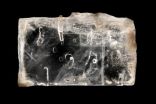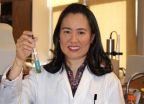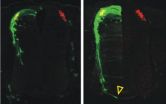(Press-News.org) From fad diets to exercise programs, Americans continue to fight the battle of the bulge. Now they'll have help from recent Tel Aviv University research that has developed a new method to look at how fat cells -- which produce the fat in our bodies -- respond to mechanical loads.
This might be the key to understanding how to control the amount of fat produced by fat cells, the holy grail of weight loss researchers, says Prof. Amit Gefen of Tel Aviv University's Department of Biomedical Engineering. His research is driven by the theory that fat cells, like bone or muscle cells, are influenced by mechanical loads, defined as the amount of force or deformation placed on a particular area occupied by cells. By recreating the structure of fat cells using a newly-developed computer method, Prof. Gefen and his team of researchers can determine how much mechanical load can be tolerated by fat cells, and at what point the cells will begin to disintegrate.
The research, recently reported in the Journal of Biomechanics, has direct applications in weight loss programs, the treatment of bedsores and the management of chronic diabetes.
Bones in space, fat on the ground
According to Prof. Gefen, applying mechanical loads on tissues can affect many different cells within our bodies. For example, zero gravity affects the bone density of astronauts. When astronauts return home after a prolonged space flight, he explains, they are often confined to a wheelchair for a small period of time. The structures of their bones and muscles, which are determined by the cells that produce these structures, are weakened due to a lack of mechanical loads. This occurs because cells are deprived of "normal" mechanical stimulation, like walking.
Prof. Gefen believes that, much like bone or muscle cells, fat cells are also affected by mechanical loads. His new computer model takes slices of laser confocal microscopy images of cells and reconstructs a whole, virtual version of an individual cell, allowing researchers to evaluate how that cell will respond to different mechanical stimuli. "We use these computer models to see how cells function under mechanical loading, much like simulations in structural engineering are used to test the strength of bridges or machines," he explains.
After assembling their "virtual" fat cells, Prof. Gefen and his group found that fat cells or lipids have a point where mechanical loads can disintegrate them, as well as a point at which they are able to resist disintegration. Prof. Gefen is now trying to determine the specific load magnitudes and frequencies for fat cells, perhaps using ultrasound at a supersonic frequency to vibrate the tissue.
Not all infomercials are light-weight
Those fat-busting "ab vibrators" that you can see on infomercials are on the right track, says Prof. Gefen, but the magnitude of mechanical loads and the frequency of their application need to be scientifically determined. Such information could be crucial to the future of our health, he says, noting that diabetes and obesity rates are rising. "Any treatment that would be effective in fighting obesity would also apply immediately to diabetes," he explains.
The next step for Prof. Gefen and his fellow researchers is to pin down the mathematical equations that allow for the dissolving of lipid droplets, then predict what a fat cell will do under certain levels of force. This will lead to better information on how to use mechanical loads to control the production of fat by fat cells -- whether this means applying a certain frequency of ultrasonic vibration, or simply spending more time in the gym.
###
American Friends of Tel Aviv University (www.aftau.org) supports Israel's leading, most comprehensive and most sought-after center of higher learning. Independently ranked 94th among the world's top universities for the impact of its research, TAU's innovations and discoveries are cited more often by the global scientific community than all but 10 other universities.
Internationally recognized for the scope and groundbreaking nature of its research and scholarship, Tel Aviv University consistently produces work with profound implications for the future.
END
Fresh insight into how biological clocks adjust to having less sunlight in the winter could help us better understand the impact of jet lag and shift work.
Scientists studying the daily activity cycle in plants – known as circadian rhythms – have discovered a finely tuned process that enables the plant's genes to respond to the times of dawn and dusk each day, as well as the length of daylight in between.
This system helps the plant to reset its internal clock every day in response to seasonal changes in daylight, which helps the plant control the timing of key activities ...
Infants are more efficient at digesting and utilizing nutritional components of milk than adults due to a difference in the strains of bacteria that dominate their digestive tracts. Researchers from the University of California, Davis, and Utah State University report on genomic analysis of these strains in the November 2010 issue of the journal Applied and Environmental Microbiology identifying the genes that are most likely responsible for this difference.
"Human milk oligosaccharides (HMOs) are the third-largest solid component of milk. Their structural complexity ...
Direct contact and droplets are the primary ways influenza spreads. Under certain conditions, however, aerosol transmission is possible. In a study published in the current issue of Clinical Infectious Diseases, available online (http://www.journals.uchicago.edu/doi/abs/10.1086/656743), the authors examined such an outbreak in their own hospital in Hong Kong.
On April 4, 2008, seven inpatients in the hospital's general medical ward developed fever and respiratory symptoms. Ultimately, nine inpatients exhibited influenza-like symptoms and tested positive for influenza ...
BINGHAMTON, NY – Binghamton University researchers recently revived ancient bacteria trapped for thousands of years in water droplets embedded in salt crystals.
For decades, geologists have looked at these water droplets — called fluid inclusions — and wondered whether microbes could be extracted from them. Fluid inclusions have been found inside salt crystals ranging in age from thousands to hundreds of millions years old.
But there has always been a question about whether the organisms cultured from salt crystals are genuinely ancient material or whether they are ...
VIDEO:
University of Missouri researchers have created a new test for salmonella in poultry and eggs that will produce faster and more accurate results than most currently available tests.
Click here for more information.
COLUMBIA, Mo. –Earlier this year, an outbreak of salmonella caused by infected eggs resulted in thousands of illnesses before a costly recall could be implemented. Now, University of Missouri researchers have created a new test for salmonella in poultry ...
Alexandria, Va. – The American Association for Dental Research (AADR) held its 3rd Fall Focused Symposium on November 12-13, in the Washington, DC, area. This year, the theme was the fast-moving field of Salivary Diagnostics, with a focus on Scientific & Clinical Frontiers. The symposium was sold-out, but AADR also offered a live Webinar broadcast of the oral sessions.
AADR created the Fall Focused Symposium under the objective to provide networking opportunities and exchange of ideas, and to offer small regional symposia focused on cutting-edge technology and techniques. ...
Both the rate and direction of axon growth in the spinal cord can be controlled, according to new research by USC College's Samantha Butler and her collaborators.
The study, "The Bone Morphogenetic Protein Roof Plate Chemorepellent Regulates the Rate of Commissural Axonal Growth," by Butler; lead researcher Keith Phan and graduate students Virginia Hazen and Michele Frendo of USC College; and Zhengping Jia of the University of Toronto, was published online in the November 17 issue of the Journal of Neuroscience.
Butler, assistant professor of biological sciences, found ...
BOSTON (11-22-10) -- Boston University researchers have developed a simple diagnostic tool that can quickly identify dangerous viruses like Ebola and Marburg. The biosensor, which is the size of a quarter and can detect viruses in a blood sample, could be used in developing nations, airports and other places where natural or man-made outbreaks could erupt.
"By enabling ultra-portable and fast detection, our technology can directly impact the course of our reaction against bio-terrorism threats and dramatically improve our capability to confine viral outbreaks," said Assistant ...
There's good news in the search for the next generation of semiconductors. Researchers with the U.S. Department of Energy's Lawrence Berkeley National Laboratory (Berkeley Lab) and the University of California (UC) Berkeley, have successfully integrated ultra-thin layers of the semiconductor indium arsenide onto a silicon substrate to create a nanoscale transistor with excellent electronic properties. A member of the III–V family of semiconductors, indium arsenide offers several advantages as an alternative to silicon including superior electron mobility and velocity, ...
RIVERSIDE, Calif. (www.ucr.edu) --A new study by University of California, Riverside scientists of what is believed to be the world's only hybrid electric tugboat found that the vessel is effective in reducing emissions at the Ports of Los Angeles and Long Beach.
Researchers at the UC Riverside College of Engineering Center for Environmental Research and Technology (CE-CERT) demonstrated the hybrid electric tugboat reduces emissions of soot by about 73 percent, oxides of nitrogen (which help cause smog) by 51 percent, and carbon dioxide, which contributes to global warming, ...


